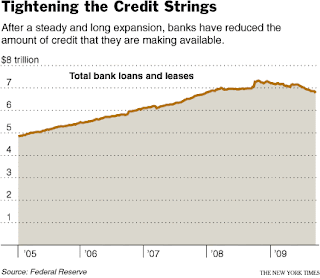

The debt-securitization market, which enabled banks to package corporate loans, home mortgages, student loans, auto loans, credit card loans, and other debts into all types of complex securities and resell them to investors, and thereby freeing the banks to lend more, has been the source of roughly 60 percent of all credit in the United States. Now, all private debt securitization has virtually dried up, though the Fed has used its $1.25 trillion credit line and spent about $905 billion buying government-guaranteed mortgages (of fanne and Ginnie Mae's and Freddie Mac) in an effort to keep mortgage rates low. The Fed is also trying to get investors to use the credit provided at attractive terms under the Term Asset-Backed Securities Loan Facility (TALF) to buy the securities.
However, as Paul Krugman argues, the end of securitization and the return to the traditional model of banks making and holding loans should be welcomed and finds no reason to consider securitization to be superior to conventional banking. He feels that instead of reviving the securitization market, the Fed should be trying to get banks to start lending out of all those excess reserves they currently hold.
No comments:
Post a Comment